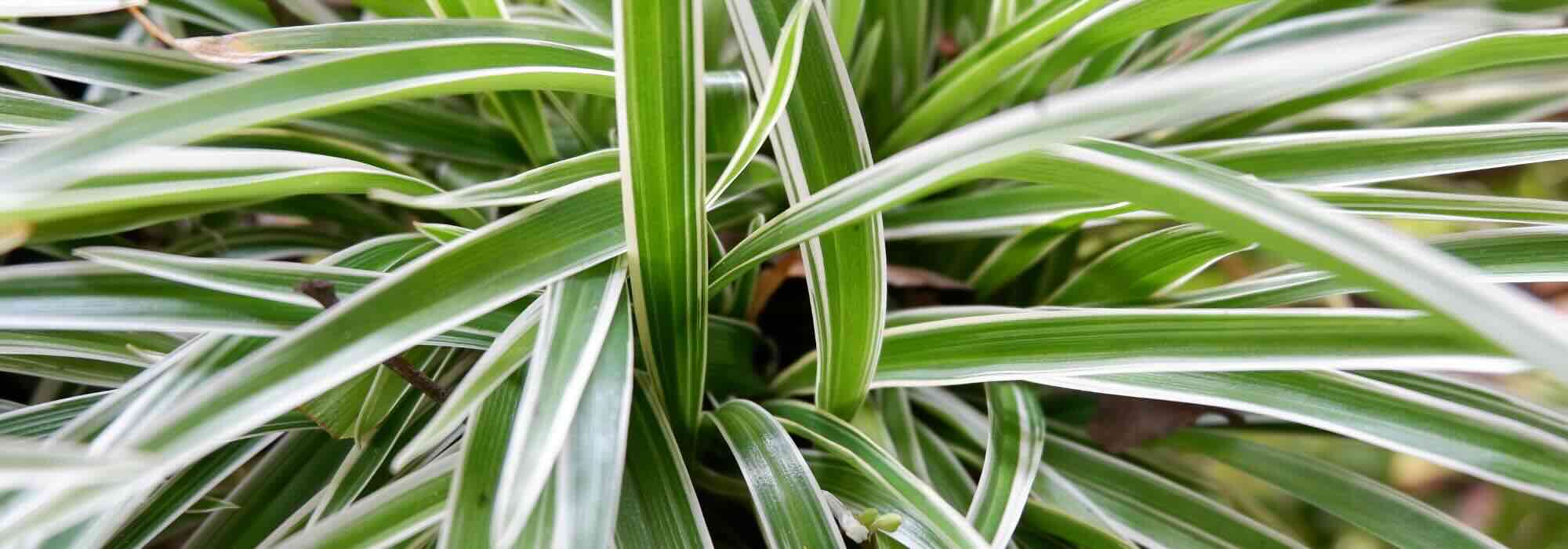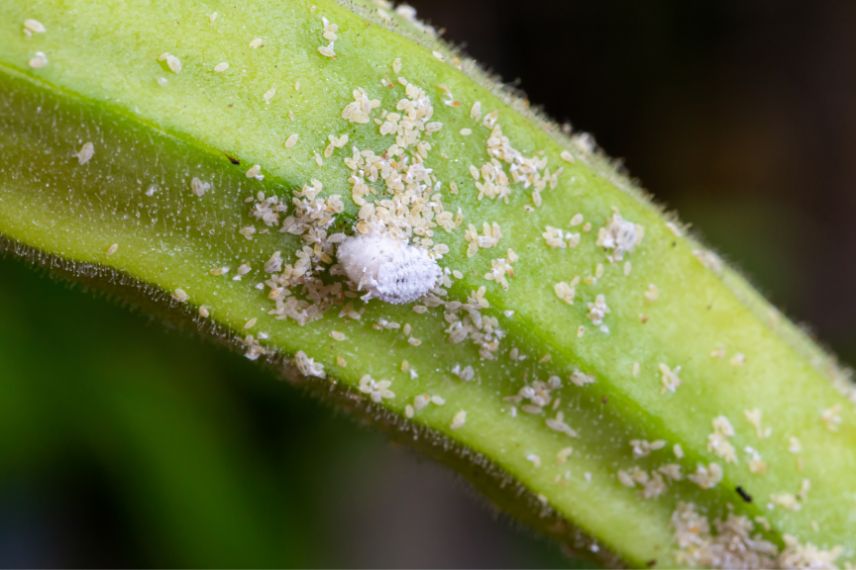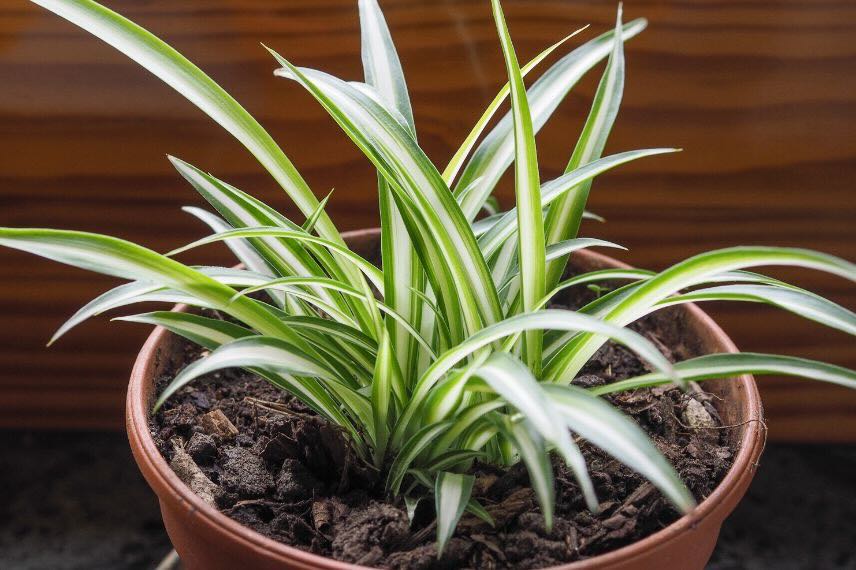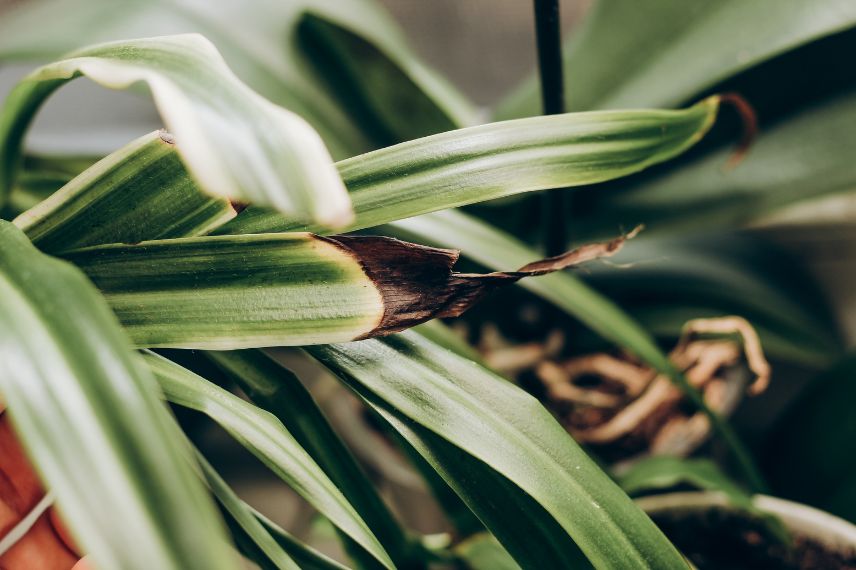
Chlorophytum: Pests, Diseases and Essential Care Tips to Know
Identify, prevent, treat your spider plant
Contents
With its long variegated leaves and charming cascading offsets, Chlorophytum comosum, or spider plant, is a popular houseplant prized for its resilience and easy care. Hardy, easy to propagate and undemanding, it appeals to both beginners and plant enthusiasts alike. But however tough it may be, the Chlorophytum isn’t immune to certain problems.
Invasive parasites, moisture-related diseases, unsightly brown tips or curling leaves: these are all signs you should know how to spot to keep your plant in top health. This article provides an overview of the most common problems affecting Chlorophytum, with simple, natural and effective advice to remedy them.
Common parasitic pests of Chlorophytum
Mealybugs
Mealybugs are among the most common parasitic pests on houseplants, including Chlorophytum. They appear as small white cottony clusters, mainly nestled at the base of the leaves or in the folds. By feeding on the sap, they weaken the plant, slow its growth, cause yellowing of the leaves, and can even encourage the appearance of sooty mould due to the honeydew they secrete.
Solutions:
- Isolate the plant to prevent spreading.
- Dab the mealybugs with a cotton bud soaked in 70° alcohol.
- Spray with a solution based on black soap mixed with 1 teaspoon of rapeseed oil and the same alcohol.
- Repeat the treatment several times to eliminate young stages and eggs.
→ To learn more, read our advice sheet on treatments to eliminate mealybugs.
Aphids
Less common but possible, aphids can also colonise a Chlorophytum, especially if it has spent time outdoors during the warmer season. These small green, black, or yellow insects gather on young leaves. By sucking the sap, they cause leaf deformations, overall weakening of the plant, and can also transmit plant viruses.
Solutions:
- Rinse the plant in the shower to dislodge as many aphids as possible.
- Spray with a mixture of water and black soap.
- Introduce ladybirds if the plant is in a conservatory.
- In case of severe infestation, apply an organic insecticidal treatment based on pyrethrum.
→ Read our article on indoor aphids for our treatment and prevention advice.
Mites (Red Spider Mites)
Mites, particularly spider mites, often appear in dry and hot conditions, which are common in heated interiors. They are tiny but leave clues: leaves dotted with small yellow spots, a dusty or dull appearance of the foliage, and sometimes fine webs at the base of the leaves. They gradually weaken the plant by damaging the foliage.
Solutions:
- Thoroughly rinse the plant in the shower.
- Apply a solution based on black soap and rosemary essential oil.
- Increase ambient humidity (misting, humidifier).
- Regularly clean the foliage with a damp cloth.
- Introduce beneficial insects like Phytoseiulus persimilis, a predatory mite for red spider mites in case of infestation.
→ Read our detailed article on red spider mites to learn more about treatments.

Mealybugs form small white clusters
Fungal diseases of Chlorophytum
Soft Rot
Soft rot is a bacterial or fungal disease that can affect the foliage and collar tissues of Chlorophytum. It manifests as softening of tissues which become translucent, soft to the touch, sometimes brownish or greyish, and often foul-smelling.
Soft rot is a general term for the rapid, wet decomposition of plant tissues, often caused by fungi or bacteria. Botrytis cinerea, also known as grey mould, is one of the fungal pathogens responsible for this type of rot. However, other microorganisms, such as bacteria from the genera Erwinia and Pectobacterium, can also cause soft rot.
This may appear after injury, excess moisture, or too frequent watering without sufficient drainage.
It is a fairly aggressive disease: affected parts decompose quickly, promoting spread if action is not taken promptly.
Solutions:
- Immediately remove affected parts with disinfected scissors.
- Reduce watering and allow the substrate to dry between waterings.
- Improve ventilation around the plant.
- Repot in healthy substrate if the base of the plant is affected, or even in a terracotta pot which allows the substrate to dry faster.
→ Read our advice sheet on botrytis for more tips.
Root Rot
Less visible initially, root rot is often caused by too frequent watering or poor pot drainage. Soil fungi such as Pythium or Phytophthora then settle in the roots and cause their decomposition: they become black, soft, sometimes slimy. The plant begins to yellow, its leaves wilt, and it stops growing.
This is a common problem in plants grown in overly compact compost or in pots without drainage holes.
Solutions:
- Gently remove the plant from its pot to observe the state of the roots.
- Cut away all blackened parts with a clean tool.
- Repot in a quality compost that is light and well-draining.
- Water moderately, allowing the compost to dry slightly between waterings.
- As prevention, disinfect the pot before repotting and avoid saucers full of stagnant water.

Terracotta pots allow better evaporation of watering water to avoid waterlogged substrates
Common physiological problems
Brown leaf tips
The Chlorophytum’s number one issue! Browning and drying leaf tips are often linked to hard water, dry air, or mineral salt buildup in the substrate (from tap water). It’s rarely serious, but affects aesthetics and may indicate care adjustments are needed.
Solutions:
- If possible, water with filtered or rainwater. Mineral salt buildup from tap water is the most likely cause of these brown tips.
- Rinse the plant under a shower head every 2 months to flush the substrate and remove salts. This is called leaching the substrate.
- Mist the foliage with soft water or place a humidifier nearby. Chlorophytum isn’t demanding about humidity but enjoys occasional misting.
- If desired, you can neatly trim the dry tips without cutting into healthy tissue.
Yellowing foliage
When Chlorophytum leaves turn yellow, it’s not necessarily disease or parasites: often it signals environmental or nutritional imbalance. Overwatering, insufficient light, nitrogen deficiency, or exhausted substrate can all cause leaf yellowing. Older leaves are usually affected first, which may be natural, but if it spreads to the entire plant, it’s a warning sign.
Solutions:
- Check watering: let the substrate surface dry before watering again.
- With plastic pots, the surface may be dry while the bottom is waterlogged. Ensure the substrate is only slightly moist.
- Move the plant if light is insufficient; though Chlorophytum tolerates medium light, so this is rarely the cause.
- Apply balanced fertiliser monthly in spring and summer.
- Repot every 1-2 years with fresh compost.
Stunted growth or dull foliage
A plant that stops growing or loses leaf vibrancy may lack light, nutrients, or suffer from compacted substrate. This vegetative fatigue often occurs after years without repotting or if placed too far from light sources.
Solutions:
- Relocate your plant to a brighter spot.
- Apply a green plant fertiliser.
- Repot your Chlorophytum in quality, light and airy compost if not repotted for over 2 years.
Leaf curling
Leaves curling inwards often signal water or heat stress. Either the plant is thirsty or exposed to excess heat (radiator, sunny window).
Solutions:
- Check substrate moisture and increase watering slightly.
- Move away from direct heat sources like radiators or south-facing windows.
- Ensure the plant isn’t in a draught.

Dry brown tips are the most common leaf damage in Chlorophytum
- Subscribe!
- Contents
































Comments